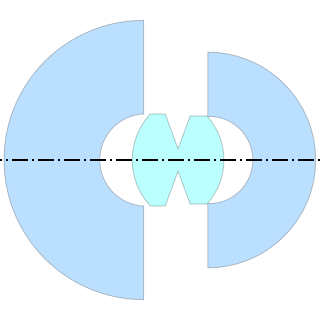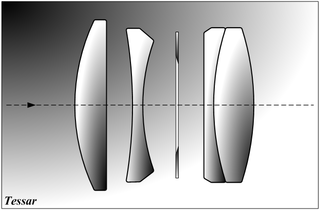
A single-lens reflex camera (SLR) is a camera that typically uses a mirror and prism system that permits the photographer to view through the lens and see exactly what will be captured. With twin lens reflex and rangefinder cameras, the viewed image could be significantly different from the final image. When the shutter button is pressed on most SLRs, the mirror flips out of the light path, allowing light to pass through to the light receptor and the image to be captured.

A rangefinder camera is a camera fitted with a rangefinder, typically a split-image rangefinder: a range-finding focusing mechanism allowing the photographer to measure the subject distance and take photographs that are in sharp focus. Most varieties of rangefinder show two images of the same subject, one of which moves when a calibrated wheel is turned; when the two images coincide and fuse into one, the distance can be read off the wheel. Older, non-coupled rangefinder cameras display the focusing distance and require the photographer to transfer the value to the lens focus ring; cameras without built-in rangefinders could have an external rangefinder fitted into the accessory shoe. Earlier cameras of this type had separate viewfinder and rangefinder windows; later the rangefinder was incorporated into the viewfinder. More modern designs have rangefinders coupled to the focusing mechanism, so that the lens is focused correctly when the rangefinder images fuse; compare with the focusing screen in non-autofocus SLRs.

Victor Hasselblad AB is a Swedish manufacturer of medium-format cameras, photographic equipment and image scanners based in Gothenburg, Sweden. The company is best known for the classic medium-format cameras it has produced since World War II.

Carl Zeiss , branded as ZEISS, is a German manufacturer of optical systems, and industrial measurement and medical devices, founded in Jena, Germany in 1846 by optician Carl Zeiss. Together with Ernst Abbe and Otto Schott they built a base for modern optics and manufacturing. There are currently two parts of the company, Carl Zeiss AG located in Oberkochen with important subsidiaries in Aalen, Göttingen and Munich, and Carl Zeiss GmbH located in Jena.

Large format refers to any imaging format of 4×5 inches (102×127 mm) or larger. Large format is larger than "medium format", the 6×6 cm or 6×9 cm size of Hasselblad, Rollei, Kowa, and Pentax cameras, and much larger than the 24×36 mm (0.95×1.42 inch) frame of 35 mm format.
The main advantage of large format, film or digital, is a higher resolution at the same pixel pitch, or the same resolution with larger pixels or grains. A 4×5 inch image has about 15 times the area, and thus 15× the total resolution, of a 35 mm frame.

Macro photography, is extreme close-up photography, usually of very small subjects and living organisms like insects, in which the size of the subject in the photograph is greater than life size .
By the original definition, a macro photograph is one in which the size of the subject on the negative or image sensor is life size or greater. However, in some uses it refers to a finished photograph of a subject at greater than life size.

Praktica is a brand of camera manufactured by Pentacon in Dresden in eastern Germany, formerly within the GDR prior to German reunification in 1990. Pentacon is the modern-day successor to Dresden camera firms such as Zeiss Ikon; for many years Dresden was the world's largest producer of cameras. Currently Praktica is the only brand sold by the company; previous brands of the predecessor firms included Zeiss Ikon, Contax, Ica, Ernemann, Exakta, Praktiflex, Pentacon, and many more.

Rolleiflex is the name of a long-running and diverse line of high-end cameras originally made by the German company Franke & Heidecke, and later Rollei-Werk.

Contax began as a camera model in the Zeiss Ikon line in 1932, and later became a brand name. The early cameras were among the finest in the world, typically featuring high quality Zeiss interchangeable lenses. The final products under the Contax name were a line of 35 mm, medium format, and digital cameras engineered and manufactured by Kyocera, and featuring modern Zeiss optics. In 2005, Kyocera announced that it would no longer produce Contax cameras.

The double Gauss lens is a compound lens used mostly in camera lenses that reduces optical aberrations over a large focal plane.
Rectaflex was the name of an Italian camera maker from 1947 to 1958. It was also the name of their sole model, the only Italian single-lens reflex camera ever built. Along with the Zeiss Ikon Contax S, it is among the first pentaprisms SLRs.

The Zeiss Sonnar is a photographic lens originally designed by Dr. Ludwig Bertele in 1929 and patented by Zeiss Ikon. It was notable for its relatively light weight, simple design and fast aperture.

The Contaflex series is a family of 35mm leaf-shuttered SLR cameras, produced by Zeiss Ikon in the 1950s and 1960s. The name was first used in 1935 on a 35mm Twin-lens reflex camera, the Contaflex TLR also by Zeiss Ikon, the -flex part in the name referring to integral mirror for the viewfinder. The first models, the Contaflex I and II have fixed lenses, while the later models have interchangeable lenses, and eventually the Contaflexes became a camera system with a wide variety of accessories.

The Tenax I is a 24x24 mm fixed lens camera by Zeiss Ikon launched in 1939.

During the 1930s, Zeiss Ikon (ZI) made a wide range of miniature cameras for the 35mm film format. Most cameras used the standard 24×36 mm frame size, like the Contax, Nettax and Super Nettel. However, the ability to take images in fast sequence was a popular marketing element at the time, and several fast-operating models were made. Among these were the Otto Berning's motor-driven Robot cameras as well as the ZI lever-operated Tenax I and Tenax II. These have the smaller square format of 24×24 mm, enhancing faster frame advance.

Biogon is the brand name of Carl Zeiss for a series of photographic camera lenses, first introduced in 1934. Biogons are typically wide-angle lenses.

Plaubel is a German camera maker, founded in November, 1902, by Hugo Schrader, who learned the technology of cameras and lenses as an apprentice at Voigtländer in Braunschweig in the late 1800s before being employed by a Frankfurt camera and lens manufacturer and distributor, Dr. R. Krügener, whose daughter he married. Hugo Schrader and his wife elected to open their own business, Plaubel & Co., as distributors and makers of cameras and lenses, naming it after his brother-in-law because he thought Plaubel was easier to remember than Schrader.

The Zeiss Hologon is an ultra wide-angle f=15mm f/8 triplet lens, providing a 110° angle of view for 35mm format cameras. The Hologon was originally fitted to a dedicated camera, the Zeiss Ikon Contarex Hologon in the late 1960s; as sales of that camera were poor and the Zeiss Ikon company itself was going bankrupt, an additional 225 lenses were made in Leica M mount and released for sale in 1972 as the only Zeiss-branded lenses for Leica rangefinders until the ZM line was released in 2005. The Hologon name was revived in 1994 for a recomputed f=16mm f/8 lens fitted to the Contax G series of rangefinder cameras.





















